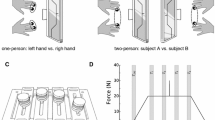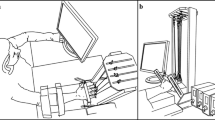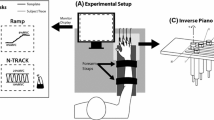Abstract
We investigated multidigit synergies stabilizing components of the resultant force vector during joint performance of a static prehension task by two persons as compared to similar tasks performed by a single person using both hands. Subjects transferred the instrumented handle from the right hand to the left hand (one-person condition) or passed that handle to another person (two-person condition) while keeping the handle’s position and orientation stationary. Only three digits were involved per hand, the thumb, the index finger, and the middle finger; the forces and moments produced by the digits were measured by six-component sensors. We estimated the performance-stabilizing synergies within the uncontrolled manifold framework by quantifying the intertrial variance structure of digit forces and moments. The analysis was performed at three levels: between hands, between virtual finger and virtual thumb (imagined digits producing the same mechanical variables as the corresponding actual digits combined) produced by the two hands (in both interpersonal and intrapersonal conditions), and between the thumb and virtual finger for one hand only. Additionally, we performed correlation and phase synchronization analyses of resultant tangential forces and internal normal forces. Overall, the one-person conditions were characterized by higher amount of intertrial variance that did not affect resultant normal force components, higher internal components of normal forces, and stronger synchronization of the normal forces generated by the hands. Our observations suggest that in two-person tasks, when participants try to achieve a common mechanical outcome, the performance-stabilizing synergies depend on non-visual information exchange, possibly via the haptic and proprioceptive systems. Therefore, synergies quantified in tasks using visual feedback only may not be generalizable to more natural tasks.







Similar content being viewed by others
References
Arbib MA, Iberall T, Lyons D (1985) Coordinated control programs for movements of the hand. In: Goodwin AW, Darian-Smith I (eds) Hand function and the neocortex. Springer, Berlin, pp 111–129
Augurelle A, Smith AM, Lejune T, Thonnard J (2003) Importance of cutaneous feedback in maintaining a secure grip during manipulation of hand-held objects. J Neurophysiol 89:665–671
Bernstein NA (1967) The co-ordination and regulation of movements. Pergamon Press, Oxford
Black DP, Riley MA, McCord CK (2007) Synergies in intra- and interpersonal interlimb rhythmic coordination. Mot Control 11:348–373
Bobath B (1978) Adult hemiplegia: evaluation and treatment. William Heinemann, London
Bosga J, Meulenbroek RG (2007) Joint-action coordination of redundant force contributions in a virtual lifting task. Mot Control 11:235–258
Danieau F, Lecuyer A, Guillotel P, Fleureau J, Mollet N, Christie M (2013) Enhancing audiovisual experience with haptic feedback: a survey on HAV. IEEE Trans Haptics 6:193–205
d’Avella A, Saltiel P, Bizzi E (2003) Combinations of muscle synergies in the construction of a natural motor behavior. Nat Neurosci 6:300–308
DeWald JP, Pope PS, Given JD, Buchanan TS, Rymer WZ (1995) Abnormal muscle coactivation patterns during isometric torque generation at the elbow and shoulder in hemiparetic subjects. Brain 118:495–510
Fine JM, Amazeen EL (2011) Interpersonal Fitts’ law: when two perform as one. Exp Brain Res 211:459–469
Fine JM, Gibbons CT, Amazeen EL (2013) Congruency effects in interpersonal coordination. J Exp Psychol Hum Percept Perform 39:1541–1556
Ganesh G, Takagi A, Osu R, Yoshioka T, Kawato M, Burdet E (2014) Two is better than one: physical interactions improve motor performance in humans. Sci Rep 4:3824
Giggins OM, Persson UM, Caulfield B (2013) Biofeedback in rehabilitation. J Neuroeng Rehabil 10:60
Goodman SR, Latash ML (2006) Feedforward control of a redundant motor system. Biol Cybern 95:271–280
Gorniak S, Zatsiorsky VM, Latash ML (2007) Hierarchies of synergies: an example of the two-hand, multi-finger tasks. Exp Brain Res 179:167–180
Gorniak S, Zatsiorsky VM, Latash ML (2009a) Hierarchical control of static prehension: I. Biomechanics. Exp Brain Res 193:615–631
Gorniak S, Zatsiorsky VM, Latash ML (2009b) Hierarchical control of static prehension: II. Multi-digit synergies. Exp Brain Res 194:1–15
Häger-Ross C, Cole KJ, Johansson RS (1996) Grip-load responses to unanticipated object loading: load direction reveals body- and gravity-referenced intrinsic task variables. Exp Brain Res 110:142–150
Hartigan JA, Hartigan PM (1985) The dip test of unimodality. Ann Stat 13:70–84
Hu X, Newell KM (2011a) Modeling constraints to redundancy in bimanual force coordination. J Neurophysiol 105:2169–2180
Hu X, Newell KM (2011b) Visual information gain and task asymmetry interact in bimanual force coordination and control. Exp Brain Res 212:497–504
Imamizu H, Kawato M (2008) Neural correlates of predictive and postdictive switching mechanisms for internal models. J Neurosci 28:10751–10765
Ivanenko YP, Poppele RE, Lacquaniti F (2004) Five basic muscle activation patterns account for muscle activity during human locomotion. J Physiol 556:267–282
Johansson RS (1998) Sensory input and control of grip. Novartis Found Symp 218:45–63
Johansson RS, Westling G (1984) Roles of glabrous skin receptors and sensorimotor memory in automatic control of precision grip when lifting rougher or more slippery objects. Exp Brain Res 56:550–564
Knoblich G, Jordan JS (2003) Action coordination in groups and individuals: learning anticipatory control. J Exp Psychol Learn Mem Cogn 29:1006–1016
Krakauer JW, Mazzoni P (2011) Human sensorimotor learning: adaptation, skill, and beyond. Curr Opin Neurobiol 21:636–644
Latash ML (2008) Synergy. Oxford University Press, New York
Latash ML (2012) The bliss (not the problem) of motor abundance (not redundancy). Exp Brain Res 217:1–5
Latash ML, Scholz JF, Danion F, Schöner G (2001) Structure of motor variability in marginally redundant multi-finger force production tasks. Exp Brain Res 141: 153–165
Latash ML, Scholz JP, Schöner G (2002) Motor control strategies revealed in the structure of motor variability. Exerc Sport Sci Rev 30:26–31
Latash ML, Shim JK, Smilga AV, Zatsiorsky V (2005) A central back-coupling hypothesis on the organization of motor synergies: a physical metaphor and a neural model. Biol Cybern 92:186–191
Latash ML, Scholz JP, Schöner G (2007) Toward a new theory of motor synergies. Mot Control 11:276–308
Martin V, Scholz JP, Schöner G (2009) Redundancy, self-motion, and motor control. Neural Comput 21:1371–1414
Masumoto J, Inui N (2013) Two heads are better than one: both complementary and synchronous strategies facilitate joint action. J Neurophysiol 109:1307–1314
Masumoto J, Inui N (2015) Motor control hierarchy in joint action that involved bimanual force production. J Neurophysiol 113:3736–3743
Mattos D, Latash ML, Park E, Kuhl J, Scholz JP (2011) Unpredictable elbow joint perturbation during reaching results in multijoint motor equivalence. J Neurophysiol 106:1424–1436
Mattos D, Schöner G, Zatsiorsky VM, Latash ML (2015) Motor equivalence during accurate multi-finger force production. Exp Brain Res 233:487–502
Mojtahedi K, Santello M (2015) Assessing control mechanisms and leader–follower roles in human–human and bimanual interactions during object manipulation. In: Abstract for Society Neuroscience, Chicago, IL, 17–21 October
Pérez F, Granger BE (2007) IPython: a system for interactive scientific computing. Comput Sci Eng 9:21–29
Pikovsky A, Rosenblum M, Kurths J (2001) Synchronization—a universal concept in nonlinear sciences. Cambridge University Press, Cambridge
R Core Team (2013) R: a language and environment for statistical computing. R Foundation for Statistical Computing, Vienna, Austria. http://www.R-project.org/
Ranganathan R, Newell KM (2008a) Motor synergies: feedback and error compensation within and between trials. Exp Brain Res 186:561–570
Ranganathan R, Newell KM (2008b) Online feedback and the regulation of degrees of freedom in motor control. Hum Mov Sci 27:577–589
Rearick MP, Stelmach GE, Leis B, Santello M (2002) Coordination and control of forces during multifingered grasping in Parkinson’s disease. Exp Neurol 177:428–442
Rearick MP, Casares A, Santello M (2003) Task-dependent modulation of multi-digit force coordination patterns. J Neurophysiol 89:1317–1326
Reed KB, Peshkin MA (2008) Physical collaboration of human–human and human–robot teams. IEEE Trans Haptics 1:108–120
Riley MA, Richardson MJ, Shockley K, Ramenzoni VC (2011) Interpersonal synergies. Front Psychol. doi:10.3389/fpsyg.2011.00038
Roerdink M, Bank PJ, Peper CE, Beek PJ (2013) Anchoring in rhythmic in-phase and antiphase visuomotor tracking. Mot Control 17:176–189
Romero V, Kallen R, Riley MA, Richardson MJ (2015) Can discrete joint action be synergistic? Studying the stabilization of interpersonal hand coordination. J Exp Psychol Hum Percept Perform 41:1223–1235
Sacheli LM, Tidoni E, Pavone EF, Aglioti SM, Candidi M (2013) Kinematics fingerprints of leader and follower role-taking during cooperative joint actions. Exp Brain Res 226:473–486
Sainburg RL (2005) Handedness: differential specializations for control of trajectory and position. Exerc Sport Sci Rev 33:206–213
Schmidt RC, Carello C, Turvey MT (1990) Phase transitions and critical fluctuations in the visual coordination of rhythmic movements between people. J Exp Psychol Hum Percept Perform 16:227–247
Scholz JP, Danion F, Latash ML, Schöner G (2002) Understanding finger coordination through analysis of the structure of force variability. Biol Cybern 86:29–39
Scholz JP, Schöner G (1999) The uncontrolled manifold concept: identifying control variables for a functional task. Exp Brain Res 126:289–306
Scholz JP, Kang N, Patterson D, Latash ML (2003) Uncontrolled manifold analysis of single trials during multi-finger force production by persons with and without Down syndrome. Exp Brain Res 153:45–58
Scholz JP, Dwight-Higgin T, Lynch JE, Tseng YW, Martin V, Schöner G (2011) Motor equivalence and self-motion induced by different movement speeds. Exp Brain Res 209:319–332
Schöner G (1995) Recent developments and problems in human movement science and their conceptual implications. Ecol Psychol 8:291–314
Serrien DJ, Swinnen SP (1998) Load compensation during homologous and non-homologous coordination. Exp Brain Res 121(3):223–229
Shim JK, Latash ML, Zatsiorsky VM (2005) Prehension synergies in three dimensions. J Neurophysiol 93:766–776
Shockley K, Santana MV, Fowler CA (2003) Mutual interpersonal postural constraints are involved in cooperative conversation. J Exp Psychol Hum Percept Perform 29:326–332
Singh T, Zatsiorsky VM, Latash ML (2014) Prehension synergies during fatigue of a single digit: adaptations in control with referent configurations. Mot Control 18:278–296
Slomka K, Juras G, Sobota G, Furmanek M, Rzepko M, Latash ML (2015) Intra-personal and inter-personal kinetic synergies during jumping. J Hum Kinet 49:75–88
Solnik S, Reschechtko S, Wu Y-H, Zatsiorsky VM, Latash ML (2015) Force-stabilizing synergies in motor tasks involving two actors. Exp Brain Res 233:2935–2949
Stoffregen TA, Giveans MR, Villard S, Yank JR, Shockley K (2009) Interpersonal postural coordination on rigid and non-rigid surfaces. Mot Control 13:471–483
Sun Y, Park J, Zatsiorsky VM, Latash ML (2011) Prehension synergies during smooth changes of the external torque. Exp Brain Res 213:493–506
Ting LH, Macpherson JM (2005) A limited set of muscle synergies for force control during a postural task. J Neurophysiol 93:609–613
Todorov E, Jordan MI (2002) Optimal feedback control as a theory of motor coordination. Nat Neurosci 5:1226–1235
Tremblay MR, Cutkosky MR (1993) Estimating friction using incipient slip sensation during a manipulation task. In: Proceedings on 1993 IEEE Robotics and Automation Conference, Atlanta, GA
van der Wel RP, Knoblich G, Sebanz N (2011) Let the force be with us: dyads exploit haptic coupling for coordination. J Exp Psychol Hum Percept Perform 37:1420–1431
Walsh EG (1997) Synchronization of human finger movements: delays and sex differences with isotonic ‘antiphase’ motion. Exp Physiol 82:559–565
Weiss PL, Keshner EA, Levin MF (eds) (2014) Virtual reality for physical and motor rehabilitation. Springer, New York, NY
Witney AG, Wing A, Thonnard J, Smith AL (2004) The cutaneous contribution to adaptive precision grip. Trends Neurosci 27:637–643
Wu Y-H, Zatsiorsky VM, Latash ML (2012) Static prehension of a horizontally oriented object in three dimensions. Exp Brain Res 216:249–261
Wu Y-H, Pazin N, Zatsiorsky VM, Latash ML (2013) Improving finger coordination in young and elderly persons. Exp Brain Res 226:273–283
Zatsiorsky VM, Latash ML (2004) Prehension synergies. Exerc Sport Sci Rev 32:75–80
Zatsiorsky VM, Latash ML (2008) Multi-finger prehension: an overview. J Mot Behav 40:446–476
Acknowledgments
The study was in part supported by NIH Grants NS-035032 and AR-048563.
Author information
Authors and Affiliations
Corresponding author
Rights and permissions
About this article
Cite this article
Solnik, S., Reschechtko, S., Wu, YH. et al. Interpersonal synergies: static prehension tasks performed by two actors. Exp Brain Res 234, 2267–2282 (2016). https://doi.org/10.1007/s00221-016-4632-6
Received:
Accepted:
Published:
Issue Date:
DOI: https://doi.org/10.1007/s00221-016-4632-6




